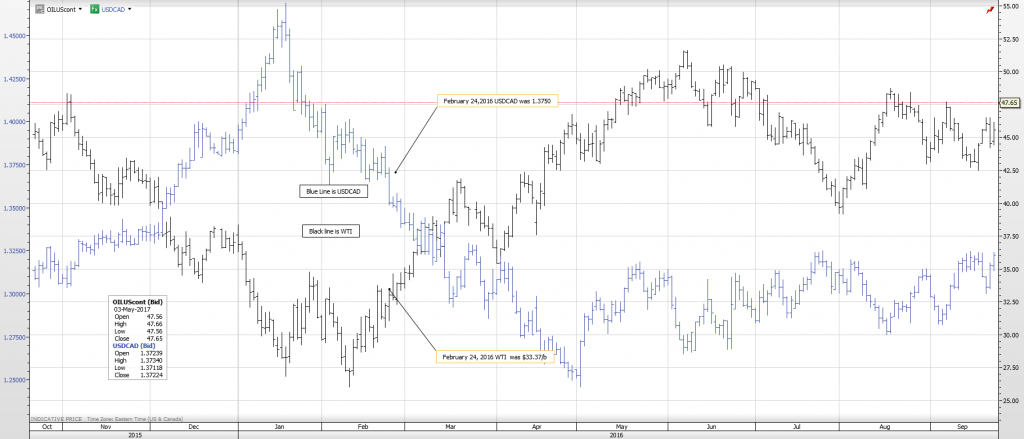By Michael O’Neill
The Canadian dollar lost more ground this week. In fact, it is even less popular then the Premier of Ontario Kathleen Wynne. Ms. Wynne’s misfortunes are of her own making while the Loonie’s unpopularity arises from a host of external influences.
A major source of Canadian dollar weakness comes from the United States. President Trump’s America-centric trade policies took aim at the Canadian softwood lumber and dairy industry. Foreign investors viewed rising trade risks as reason to sell Canadian dollars.
President Trump’s plans to slash corporate and personal taxes has created fresh US dollar demand on speculation that the new policies will turbo-charge the American economy.
Yet, those initiatives were merely warm-up acts. The star of the “Sink the Loonie” show is Janet Yellen and the Fed, specifically, the Federal Open Market Committee. On May 3, the FOMC announced that they were leaving the federal funds target range unchanged at 0.75 percent-1.0 percent. That news was almost universally expected.
For the most part, the policy statement met the expectations. Many analysts believed that the Fed would downplay the first quarter weakness. They did. They also expected that the Fed would overlook the weak employment report in March. They did
But FX markets are fickle. Even though the FOMC apparently delivered close to market expectations, the US dollar gained across the G10 currency spectrum in the aftermath of the announcement.
It seems that traders concluded the statement was hawkish because it didn’t sound doveish.
The Canadian dollar was a victim of that sentiment.
On May 2, the Canadian dollar was swamped by a wave of sellers. Home Capital Group, an alternative mortgage lender, was under scrutiny by the Ontario Securities Commission who had released a “statement of allegations” on April 19. That news caused Home Capital to lose depositors. National Post columnist Terence Corcoran describes the OSC allegations as “at best contentious and are irrelevant to Home’s corporate condition”.
On April 26, Home Capital shares dropped 65 percent after they announced that they needed to raise funds to stem the tide of fleeing depositors.
Home Capital’s woes spread to other alternative mortgage lenders but for the most part, the Canadian dollar was blissfully unconcerned.
That changed on May 2. The Canadian dollar took, what appeared to be, a random dive. One theory is that a few traders in New York speculated that the so-called “Canadian Housing bubble’ was about to burst. They bought USDCAD.
These traders didn’t realize that unlike their US counterparts, Canadian mortgage lenders didn’t issue two or three mortgages on the same property to a person earning minimum wage or to a family pet.
USDCAD roared higher. It started from 1.3650 and didn’t stop until it hit 1.3754. It has since retreated from that level but the retreat was shallow.
The fact that the USDCAD decline from the May 2 high was shallow, gave rise to another theory. Some speculated that the a very large order to sell Canadian dollars and buy US dollars was being pushed through the market, citing the recent oilsands divestitures as a potential source.
And speaking of oil, the last time USDCAD was at 1.3750, West Texas Intermediate oil (WTI) was at $33.37/barrel. (February 2016)
WTI closed in New York on May 3 at $47.55/barrel. All things being equal, either WTI is overvalued and about to collapse, or the Canadian dollar is very cheap and due for a correction.
Chart: USDCAD and Oil—Daily highlighting February 2016
Source: Saxo Bank
The problem is that all things are not equal. Oil prices are just one factor in the value of the Canadian dollar. Other factors include supply and demand, non-energy commodity prices, inflation, trade and interest rates, to name a few.
The European Central Bank played an indirect role in the value of the Canadian dollar in the past month. Currently, ECB interest rates are negative and they are spending €80 billion per month in a quantitative easing program to stimulate growth. That program is scheduled to end at the end of this year. There are many opinions about when to begin tapering. Traders see tapering as the road to higher interest rates. Guessing when the ECB will divulge their tapering plans is one of the reasons why EURUSD has climbed nearly 0.0600 points since January. The move also fueled buying of EURCAD which was another factor in the Canadian dollar’s slide.
In less than three weeks the Canadian dollar has shed 5.25 percent of its value, making it the worst performing G10 currency in that timeframe. However, it is unlikely to be voted out of office, unlike Ontario’s premier who is slightly more popular.







